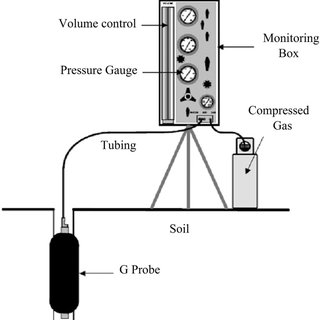Pressuremeter test (PMT)
What is PMT?
The pressuremeter test (PMT) is an in-situ test to estimate the amount of some soil parameters such as the elastic modulus. In simple words, PMT is performed by applying pressure to the sidewalls of a borehole, measuring the corresponding soil deformation.
Briefly, a probe is placed in the borehole, then it is gradually filled with water. The resulting soil swelling around the borehole is measured as a function of water pressure. Finally, the load-deformation curve is plotted to provides 2 pieces of information, namely Menard modulus Em and limit pressure pLM .

Presuremeter Setup

PMT Procedure
The general procedure of PMT
The test procedure consists of three steps as follows:
- Drilling a borehole
- emplacing the probe into the bore bole
- applying the pressure and recording the results
Different type of pressuremeter test
Depending on the installation process of the probe, different PMT methods have been developed as following:
- The borehole pressuremeter: The probe is placed into a borehole.
- The self-boring pressuremeter: in this method, the probe is self-bored into the ground. Insertion must be carried out with minimize possible soil disturbance.
- Displacement pressuremeters: in this method, the probe is inserted into the soil. ro reduce the disturbance, soil, the soil displaced by the probe enters the container of instrument,
Results of Pressuremeter Test
The ultimate result of the test is a 2D curve, in which x- axis is the volume of water used for each increment of the probe, and y-axis is on the pressure value obtained for each increment. As other in-situ tests, the results of PMT may contain some errors. To avoid these errors, prior to test, the instrument should be calibrated for pressure loss, volume loss and hydrostatic pressure head
Standards
To see detailed information about the exact procedure of PMT, you can consult to BSI BS 5930 Code and also ASTM D4719 – 07.



Comments